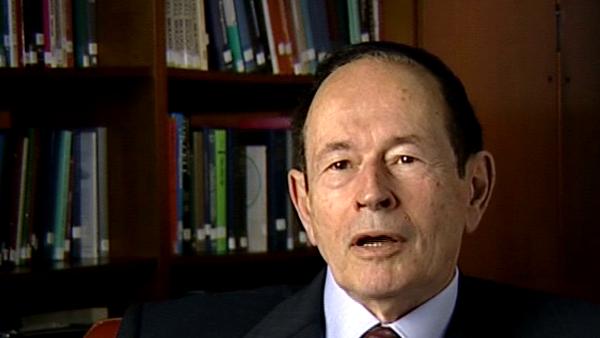NEXT STORY

Lunch at the Rockefeller Institute
RELATED STORIES

NEXT STORY

Lunch at the Rockefeller Institute
RELATED STORIES



Well, that was an amazing thing, and a thing again like the Mass General itself that cured my... any snobbery that might have come from being an autodidact, because that of course was another great institution, and in those days... in the early Rockefeller Institute there was a style which we don't see much anymore. You know, you and I have talked about this. So what was that style? Well, it was the idea of having people develop their own views – not in some departmental organization or some coterie or some category, and there was nothing heritable about it. Every lab was centered around a particular individual and his style. But that style, while it was idiosyncratic, had a shared belief amongst all of them; they all had this almost quasi-religious belief in the powers of science. And this chap Bronk, who was in fact a dean at Swarthmore College and then was at this Johnston Foundation which I originally mentioned and where I had worked, and finally became President of Johns Hopkins University, was in fact at that time President of the National Academy of Science and he then became President of the Rockefeller; and he had this brilliant idea of setting up a graduate program, in the broadest sense, where you just didn't do it the way they did in the universities – in fact you didn't have a committee, you had an interview with Bronk, usually a walk in New York for two hours, in which you were asked the most remarkable variety of questions. And he personally chose the students, and I have to say he was some kind of small genius because that student program within rapid order became the leading one in biology in America, even though there were great institutions in competition – for example, Harvard itself. So it was an extremely fortunate thing that I... that I got there.
And what happened at that point is I decided to exercise my interest in... in this antibody molecule which was called gamma globulin in those days. There's an interesting referent here because that book I mentioned I read in Paris by Cohn and Edsall; Cohn was the man who fractionated serum for military purposes, and Cohn fraction two... usually ammonium sulphate fractions, Cohn fraction two was the gamma globulin fraction, it wasn't exactly pure; it was my good luck to get a huge bottle of it from human placentae, of all things, from Lederle Labs in New Jersey. And so that was my sort of bailiwick; I could dig in and do all kinds of things.
Well, I began to be very interested in physical chemistry and in molecular structure, and I decided I would work on that. And I have to say one of Bronk's great attributes and remarkable notions was apprenticeship was the key – not pedantry and lots of courses. In fact, we didn't have any courses. So I sort of taught myself again physical chemistry. A little later on I got some help from some trained physical chemists but, initially, I got into protein physical chemistry. And it was there that I decided I would really go after the structure of the antibody molecule. That hope and that assertion turned out to be extraordinarily naïve because I didn't have any idea of how difficult a task it was going to be. Nonetheless that pretty much gives you an indication of how accidental all of these things are; they aren't really – if I hadn't read that book in Paris, if I hadn't had the naïve thought about going after this molecule, the terrors of which did not yet overwhelm me, I wouldn't have started.
US biologist Gerald Edelman (1929-2014) successfully constructed a precise model of an antibody, a protein used by the body to neutralise harmful bacteria or viruses and it was this work that won him the Nobel Prize in Physiology or Medicine in 1972 jointly with Rodney R Porter. He then turned his attention to neuroscience, focusing on neural Darwinism, an influential theory of brain function.
Title: Developing my interest in gamma globulin at the Rockefeller Institute
Listeners: Ralph J. Greenspan
Dr. Greenspan has worked on the genetic and neurobiological basis of behavior in fruit flies (Drosophila melanogaster) almost since the inception of the field, studying with one of its founders, Jeffery Hall, at Brandeis University in Massachusetts, where he received his Ph.D. in biology in 1979. He subsequently taught and conducted research at Princeton University and New York University where he ran the W.M. Keck Laboratory of Molecular Neurobiology, relocating to San Diego in 1997 to become a Senior Fellow in Experimental Neurobiology at The Neurosciences Institute. Dr. Greenspan’s research accomplishments include studies of physiological and behavioral consequences of mutations in a neurotransmitter system affecting one of the brain's principal chemical signals, studies making highly localized genetic alterations in the nervous system to alter behavior, molecular identification of genes causing naturally occurring variation in behavior, and the demonstration that the fly has sleep-like and attention-like behavior similar to that of mammals. Dr. Greenspan has been awarded fellowships from the Helen Hay Whitney Foundation, the Searle Scholars Program, the McKnight Foundation, the Sloan Foundation and the Klingenstein Foundation. In addition to authoring research papers in journals such as "Science", "Nature", "Cell", "Neuron", and "Current Biology", he is also author of an article on the subject of genes and behavior for "Scientific American" and several books, including "Genetic Neurobiology" with Jeffrey Hall and William Harris, "Flexibility and Constraint in Behavioral Systems" with C.P. Kyriacou, and "Fly Pushing: The Theory and Practice of Drosophila Genetics", which has become a standard work in all fruit fly laboratories.
Tags: Rockefeller Institute, Proteins, Amino Acids and Peptides, Detlev Bronk, Edwin Joseph Cohn, John Edsall
Duration: 3 minutes, 52 seconds
Date story recorded: July 2005
Date story went live: 24 January 2008